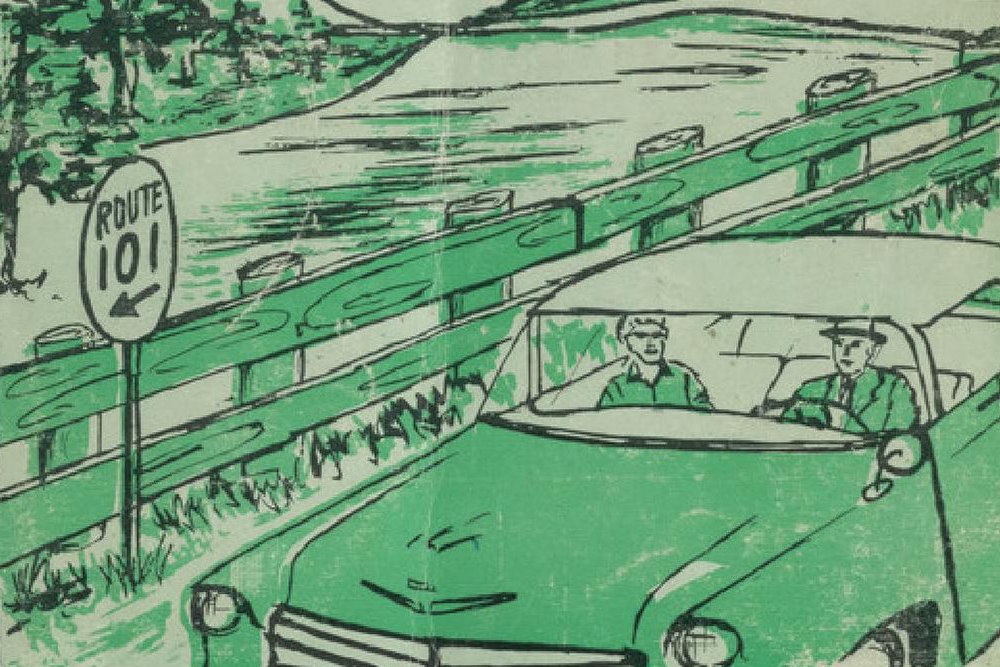interviews
What Does It Mean to Perform Whiteness?
Brit Bennett, author of "The Vanishing Half," on stories of passing and not writing a how-to guide for white people

Brit Bennett’s sophomore novel, The Vanishing Half, opens in the fictional town of Mallard, Louisiana. Mallard is founded as a haven for, and populated exclusively by, light-skinned Black people; in this town, we’re told, “nobody married dark.” The novel starts with the return of Desiree Vignes, who fled with her twin sister Stella at age sixteen. Years later, she’s left her husband and returned with her daughter, Jude, whose dark skin alienates her from Mallard’s inhabitants. Her twin, whom she hasn’t spoken to in years, took a different route: While applying for a secretarial job as a young woman, she’s mistaken for white and discovers the possibility of “passing over.” Stella decides to abandon Desiree, marry a rich white man, and break with her history to lead the life of privilege that whiteness affords. The novel follows the twins’ divergent paths, tracking the echoes through the next generation––Stella’s daughter Kennedy and Desiree’s Jude––as their daughters build their own lives and explore the buried past.
Opening in the late 60s, The Vanishing Half unfolds with the lightness and symmetry of a fairy tale, while still reflecting much of our present reality. Its events are set against the backdrop of protest and political upheaval. There’s a keen sense, in its pages, of how larger social currents shape the movement of individual lives.
As well as coming out during the pandemic, the novel’s publication date––June 2nd––coincided with “blackout Tuesday,” when people across social platforms posted black squares as a show of solidarity with the Black Lives Matter movement, but ended up obscuring on-the-ground information for organizers. The buzz for Bennett’s novel was already considerable––HBO recently won an auction for the rights to turn The Vanishing Half into a limited series––but the social movements of the past few months have only served to buoy it up further. This strange convergence, and the broader response to Black storytelling we’re seeing unfold, is one of the things Bennett and I discussed in our phone conversation, along with the implications of performing whiteness and the uneasy comforts of community.
Tajja Isen: Given our current context, I want to start by asking you about the presence of protests in the novel. Even as it focuses on individual lives, it’s attuned to various collective struggles––the protests after Dr. King’s assassination, women’s liberation, the AIDS crisis. What role did you want protest to occupy in the narrative?
Brit Bennett: I knew I wanted to set the book during this time period that was quite tumultuous, and was also a moment of pretty radical social and political change. Beginning the book in the wake of Dr. King’s assassination and the uprisings that happened in that moment felt really interesting and right. My mom actually moved to D.C. the week that Dr. King was killed––that was her first time ever leaving her small town in Louisiana and really being out in the larger world, and she arrived in this moment of actual history being made. I’ve always been really struck by that bit of family lore, the idea of my mom at 19 years old being out in the world for the first time in the midst of this tumult.
If Stella can easily perform whiteness, then what does it mean to be white?
It was also particularly interesting to think of Desiree in that moment, because this was a moment of collective grief and rage, but also a moment where people are required to identify themselves in some way. So, the idea of Desiree, as this woman who is a bit more racially ambiguous, being caught in that situation [interested me]. Up until this point, has experienced her lightness as, or at least has been told it is, this sort of advantage.
I was interested in these moments of collective struggle as a backdrop for characters’ individual lives mostly because I think that’s the experience of being alive. We have our specific and intimate problems that we’re dealing with, and then at the same time we’re living through a pandemic. I thought my mom’s story was always such a great example of that—she’s trying to find furniture for her apartment while in the middle of this huge historical moment. I wanted the characters to be balancing between those poles.
TI: A lot of characters in the novel have the impulse to justify themselves in opposition to groups––to be like “I’m not like other [blank]”––whether that’s “I’m not like my twin”; “I’m not like the town I come from”; “I’m not racist like those other white people”––what’s interesting to you about this impulse to hold oneself apart?
BB: I think that’s another thing that’s interesting about communities: they’re ways to measure ourselves. There’s a pleasure that can come from being part of a group, but then there’s also that horror that you’re being conflated with a group of people that you don’t want to be conflated with. In the case of Mallard, you’re introduced to this community immediately on the first page, when you see how they react to this child who’s arrived who’s dark-skinned. The idea of Desiree being somebody who’s very much, from the beginning, interested in separating herself from this town, even though she’s kind of the embodiment of what they value—and then, not only that, but returning with this child who is very resoundingly rejected by that same town—there was always something very interesting to me in that complication.
I’m not “anti-group,” but I do feel like a lot of novelists consider ourselves introverted, and maybe that’s also part of my suspicion of groups as I’m writing about them. But I think that idea of, “What part of me belongs to this group and what part do I want to be apart from this group,” I think that’s something we are all constantly negotiating as we move through the world.
TI: There’s also a terror around singularity, too. At one point, Jude thinks, “People thought that being one of a kind made you special. No, it just made you lonely.” Kennedy, too, thinks, “Belonging to a pattern was safe, at least, to be singular was a risk.” What is it about uniqueness or singularity that can be so terrifying?
BB: I think that’s the other side of it. There’s some level of vulnerability [in] being by yourself, of standing apart from the group. Groups often do offer a measure of protection, whether physical or just psychological and emotional. Being part of a group can make you feel claustrophobic and trapped, but can also make you feel protected. And it’s scary sometimes to leave that group.
TI: Zooming out a bit, what was it about the passing narrative that compelled you to write about it?
BB: The story really began with the idea of this town. I started to think about a sister who passes for white and disappears, and a sister who marries a dark-skinned man and returns to that town with a dark-skinned child. There was something really fascinating about the idea of those diverging paths. I think twins often lend themselves to these very metaphorical readings of identity and choice, and that was something that felt like it emerged organically out of the source of the novel, which is really the idea of this place.
Beyond that, to me, what’s most interesting [about passing narratives] is, one, there’s a sense of unknowability about passing—if you’ve done it successfully nobody will know that you’ve done it. There’s something about that that’s inherently very mysterious, and as a writer, you love mystery. But beyond that, there’s also something inherently very contradictory about passing stories.
On one hand, by Stella passing for white, she is this transgressive figure, and she’s sort of destabilizing these categories of race by showing that you can move between them and also perform them. If Stella can easily perform whiteness, then what does it mean to be white? Does it hold the cultural meaning we’re told that it holds? But the flip side of that idea is that all of the things she gains as a white woman, she’s only able to gain because she is white. By marrying this rich white man and gaining this power and wealth and status, she’s not improving life for other Black people––she’s only improving life for herself, and only as a white person. So, on one hand [passing stories] destabilize race, and on the other hand, they reaffirm race as the meaningful category. There’s something at the heart of that that made me want to write toward this long and very storied tradition, but also from my perspective as a 21st-century writer.
TI: I want to talk about Stella a bit more, and her decision to live as white, which is often described as a matter of choice. I’m curious about the way you found a balance between the freedom of that choice and also the violence of that subject position––she participates in various hypocrisies that underlie white womanhood. How did you walk that line and think through that?
BB: A lot of that was at the heart of what became really fascinating about Stella. It takes her a while to really claim agency over the fact that she has chosen anything. She kind of stumbled into passing, in a way; she’s mistaken for a white woman and she just goes with it. I think there’s something about the haphazardness of the initial choice that allows her to safely act like she was just kind of swept up in this life, and then later has to come to face the fact that this was actually a huge act of agency, and she has to claim that. I feel like she is the character who exercises the most agency in the book, but I don’t think she sees herself in that way. That was very important to think about as I was writing her.
I also wanted to think about the ways that, on one hand, she’s choosing something that, at least to me, feels like it would be really liberating. Race aside, the idea of living somewhere where nobody knows you and starting completely over––I love my friends and family, but there’s always this part of me that finds that idea to be really freeing. And there’s a way in which [Stella is] able to do that as a white woman. The idea of choosing to be white and never talking to my family again––that’s something that I cannot really imagine, ever. But the idea of her creating herself again, that’s something I could access. But as you said, also, that’s not a decision that comes with no cost: There’s the cost of what she’s asked to personally sacrifice as far as her family and her community and her culture, and there’s also the ways in which she chooses to enact this racist violence as a white woman. These are things that she is choosing that she does not have to choose. But the ways in which she commits to being a white woman and leveraging the power that she has as a white woman––that is what begins to make her feel she has finally, successfully completed this act [of passing] and, again, is also a choice.
TI: The novel deals with a lot of violence and loss, but also has moments of incredible joy and is paced with such a light touch. How did you think about or approach the pacing, and create that sense of propulsion?
There’s something strange about writing a novel that you think of as art and having it translated as a sort of how-to guide for white people.
BB: Writing something that’s just relentlessly brutal is both hard for the writer to sustain and not as effective for the reader, because after a while you get numbed to the drudgery of the characters who are experiencing relentless misery. Obviously, it also depends on the kind of book you’re writing, but for me, I can’t sustain that. It’s the same thing as when you’re watching a horror movie and there’s a jump scare. The jump scare works because it allows you to release the tension. You jump, and then you’re laughing a little bit—it gives you that break. I think that joy operates in a similar way. It gives you a break; it gives you a moment to breathe. I’ll also say that I find joy a lot harder to write than tragedy. I think that writing things that are sad is a lot easier. So, I try to pay close attention to those moments of joy and try to make them feel real and not cheesy and not overly sentimental. That’s very important when I’m thinking about how to structure a novel: What is the moment when the reader needs to let a breath out and just sort of relax a little bit?
TI: I’ve been thinking a lot about the way the work of Black writers is being positioned right now. There’s so much exciting stuff being published. But how do you feel about the way those stories are being received?
BB: I had a few months to realize, “Okay, this book is going to come out during this pandemic,” and I had wrapped my mind around that and what that might mean. I was not expecting my book to come out the day everybody was posting black squares on Instagram, or the week in which people started circulating anti-racist reading lists, and that the conversation would somehow turn to, “We need to read books to learn how to not be racist.” Obviously, I’m happy to find readers or for readers to find me however they do. But I do think there’s something strange about my book being collected on an anti-racist reading list, in part because I felt like a lot of those books that people were referencing were books written by educators attempting to educate. And that’s not what this book is at all. I’m not equipped, nor am I interested, in teaching anyone how to be anti-racist. There’s something strange about writing a novel that you think of as art and having it translated as a sort of how-to guide for white people. There’s something about that that I find disheartening.
I’m not getting tagged in anti-racist things anymore, so I don’t know if the zeitgeist has moved onto something else; I don’t know if white people are still interested in engaging with those books on race that they were so eager to buy a couple of months ago. But I hope that with all of the really exciting fiction by Black artists that is coming out now, that people will engage with them as art; as something that’s meant to be beautiful and not just meant to instruct you. For a lot of us, we’re writing novels because we think novels are beautiful, and we want to write something that’s moving; we want to write something that’s fun, or entertaining, or any of the things that we turn to fiction to do. I hope that people read those books for those reasons also.









